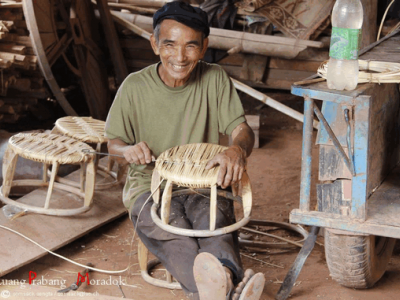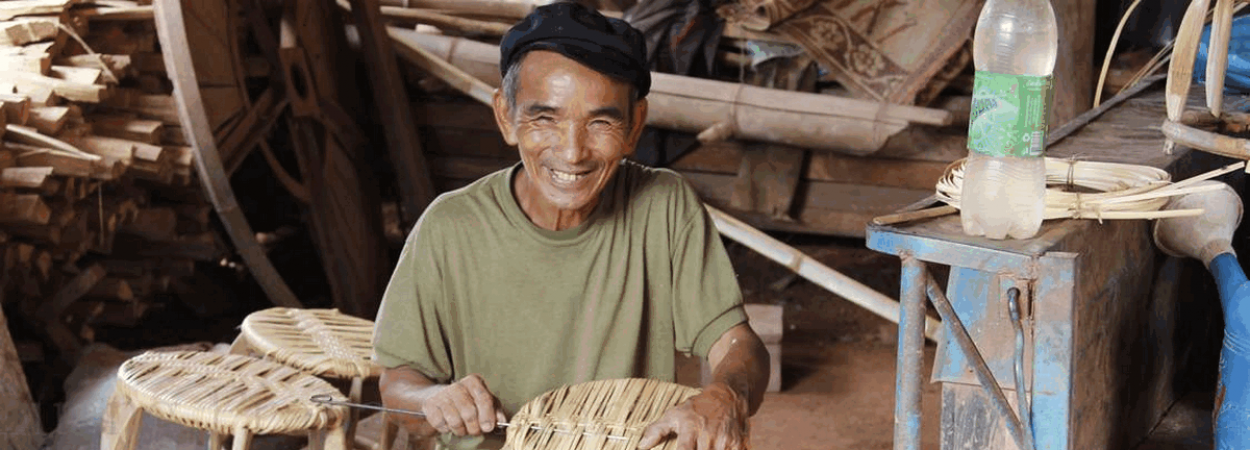Lao people are quite crafty when it comes to turning plants into items they can use. They can transform cotton into decorated skirts, bamboo into musical instruments, and clay into urns and lamps
Cotton Weaving: Watch and learn the entire cotton weaving process, from picking to weaving, at several Lao villages. Start with deseeding and softening raw cotton, before rolling it into tubes. Continue with spinning that ends at a rack of spools. The cotton is placed in vats of natural dyes, before reaching looms tucked under houses.

Silk Weaving: Observe women convert caterpillar cocoons into prized Lao silk. Watch weavers work purpose-built looms, such as massive contraptions hanging from rafters and back-strap laptops. Other techniques include mat mee – turning tie-dyed threads into complex designs for tin sin (decorative hems for traditional skirts).
Bamboo & Rattan: Lao is a basket case when it comes to creating light-weight, durable, termite-resistant goods from bamboo and rattan. Watch craftsmen produce storage and carrying baskets, furniture, cups and spoons, fish traps, rice steamers, and even an entire house! Clever women manage to produce paper from dried bamboo pulp.
Woodcarving: Lao people have been chiselling wooden sculptures for centuries. Woodcarving became an important skill for creating Buddha images, temple door frames, pillars, and roofs. During the Lane Xang Era, artisans produced thrones and ornate furniture. Today, you can watch woodcarvers in action, and purchase small sculptures as souvenirs.
Lao Khao Whiskey: Dare yourself to take a sip of Lao rice whisky, and buy a bottle for yourself. Lao khao is a part of Lao life, and village visits can add moonshine to your checklist of winery and brewery tours. Watch the masters cook mashed rice in a process that ends with a plastic jug waiting for a pipe to drip the sweet-tasting booze. Plants and animal organs can be added for medicinal purposes.
Non-Timber Forest Products (NTFPs): Many visitors love treks through massive primal trees, but forests present a world of products not used for wood and paper. Guides point out NTFPs used for food, tools, handicrafts, and medicine. Finished products vary from ginger candy, sugar cane juice, banana liquor, and honey to cosmetics, beeswax lip balms, brooms, and nyang oil for torches.
Pottery & Ceramics: Lao pottery dates to the 2nd century, with glazed ceramics appearing 500 years ago. Step back in time and learn the entire process from finding and gathering different types of clay to throwing and decorating your own pot. Today, Lao pottery and ceramic producers have expanded their product range to vases, lamps, candlestick holders, and decorative bowls for sale.
Musical Instruments: The entire Lao orchestra is an ensemble of handicrafts. The woodwind section stars the khene, a tiered, bamboo-tube mouth organ. The coconut so u fiddle leads the strings, and the brass khong vong tuned gongs boom in percussion. You can listen to the kacchappi lute, multi-plate ranyat xylophones, bamboo khui flutes, and reed pi kaeo oboe.
Lao Painting: The art of Lao painting is rooted in Buddhism, and you can examine the work on story-telling stucco murals at most temples. These religious paintings have no perspective, shadows, or shading, and use simple lines. French colonials introduced Western-style oil and water-colour paintings, but today’s modern artists need to support themselves by painting landscapes and scenes for tourists.
Source: Wearelao

